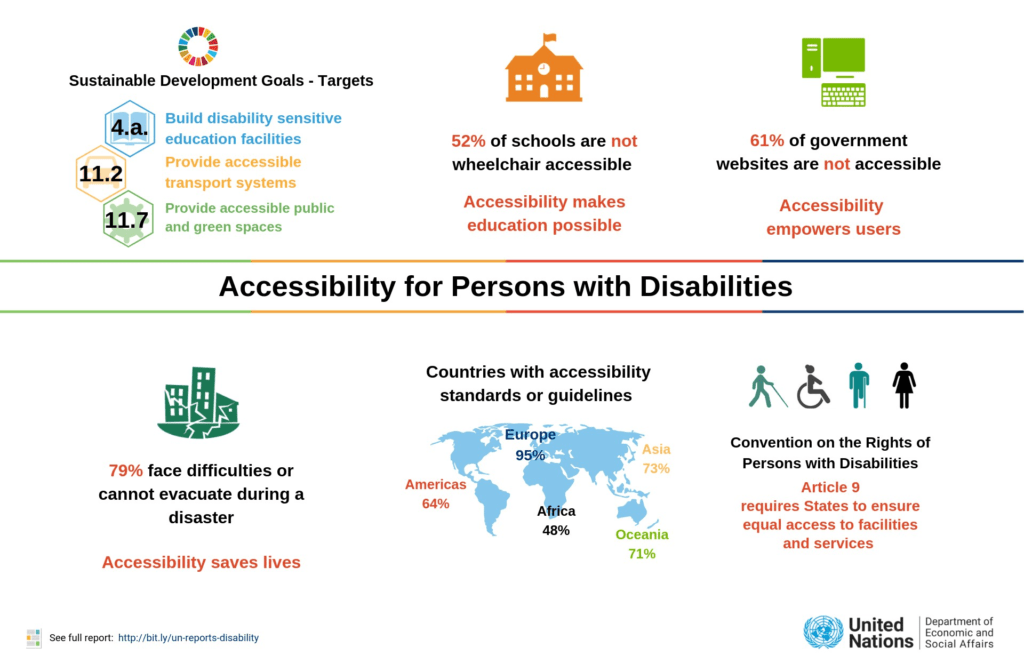1 November 2022 In Active Mobility, Africa, Blog Post, Climate Change, Road Safety, Social Equity
Overcoming Arrested Mobility for Persons with Disabilities Across Africa
Figure 1: International White Cane day, Swakopmund, Namibia
Photo courtesy of Adam Hartman, The Namibian News (2020).
Willy Johannes has been diagnosed with congenital blindness, a condition which has affected his sensory organs and has caused him mild visual impairment from birth. Due to his condition, Willy is restricted in his daily movements due to a lack of adequate inclusion in mobility policies and infrastructure – or so-called “arrested mobility”. Despite his condition, Willy exudes confidence and optimism for the future and advocates for a transport and mobility system-wide inclusion for persons with disabilities (PWDs).
“Ever since my childhood, even with a white cane and the help of a mobility specialist to learn how to navigate my environment, I am still unable to walk around safely and easily in my neighbourhood. Sidewalks that abruptly end, uneven sidewalks and curbs have been a major challenge and are stressful to navigate.” – Willy.
Willy’s daily mobility struggles resonate with many people living with other forms of physical disabilities globally. Over one billion people globally live with some form of disability, about 10% to 15% of the world’s population, and this number is increasing every year. By 2050, the number of PWDs is projected to double to two billion1,2 (Figure 2).

Figure 2: WHO Disability Statistics
Source: United Nations Convention on the rights of Persons with Disabilities (CRPD)3
About 80% of PWDs live in developing countries, with an estimated 60 to 80 million living in Africa (a majority of which are of working age (80%) or female (55%)). On average, PWDs are estimated to account for 10% of the continent’s population, with the proportion possibly as high as 20% in the poorer regions.1 Sadly, there has been an apparent underreporting of disability in low-income countries, which can be attributed to the stigma associated with disability and to an extent the reporting methods used.4 There is also a significant information gap on the extent of PWDs in avoiding travel due to poor access to safe walking infrastructure and transport services.2,5
As a consequence, many African countries omit or superficially include PWDs in their transport policy frameworks.6,7,8 The lack of acknowledgement in mobility policy frameworks and accommodation in infrastructure and services further stiffened “arrested mobility” – PWDs are marginalised from society and are unable to fully enjoy the basic rights and freedoms of a socially inclusive life. In fact, studies show that on average, PWDs make much fewer trips in a day than people that are not PWDs, due to concerts on aggressive or distracted drivers and able-bodied pedestrians, lack of access to public transit and the lack of inclusive walkways.
“I want to be a productive member of society, but I have to face many mobility barriers to access good education, health services and even employment opportunities. I do not want my condition to be viewed as an inability to positively contribute to society.” – Willy
The 2030 Agenda for Sustainable Development has made a commitment to PWDs that “by 2030, provide access to safe, affordable, accessible and sustainable transport systems for all, improving road safety, notably by expanding public transport, with special attention to the needs of those in vulnerable situations, women, children, persons with disabilities and older persons”9 (Figure 3).

Figure 3: Sustainable Development Goals: Accessibility for Persons with Disabilities
Source: United Nations Disability and Development Report 201910
With the United Nations Climate Change Conference 2022 (COP27) taking place in just a little more than a week, we, as the SLOCAT-VREF Young Leaders in Sustainable Transport, want to tell policy makers around the world that there are lots of ways to help PWDs overcome arrested mobility.
- Improving data collection, information and communications technology (ICT) and infrastructure.
“It is important to highlight and understand the active mobility issues faced by people with disabilities within the African region for them to realise the opportunities available to them – through improved quality data collection. Mobility stakeholders at COP27 need to fully commit and give adequate priority to addressing active mobility infrastructure and access barriers to aid the integration of PWDs into public life and to aid them to make an economic contribution to society by providing sustainable, environmentally friendly and barrier free mobility systems.”
 Robert Ambunda (University of Namibia)
Robert Ambunda (University of Namibia)
A deeper understanding is needed of how different individual circumstances intersect with mobility environments to produce and deepen inequalities. While disabled populations face an increased risk of road traffic injury, the lack of data both on social and environmental factors contributing to high-risk scenarios as well as on disability status makes targeted interventions to improve active mobility difficult.11
“Gathering data on various aspects of the built environment is key to improving the quality of active travel for disabled persons. For example, OpenStreetMaps is a global initiative to crowdsource data on everything from large points of interest down to the tiniest of details, like whether the pedestrian crosswalk button has accessibility features like sounds or vibrations. Collecting this information into an open data format is critical not only to power information systems to help disabled persons plan journeys that work for them, but also to identify gaps in the city where there is room for improvement.”
![]() Bianca Ryseck (Arup)
Bianca Ryseck (Arup)
ICT data can help build navigation and mapping tools for persons with disabilities. Notably, there is potential to make this happen as more than 80% of Africa’s urban areas have 4G network coverage.12 Moreover, many use smartphones, but access among the older population cannot be guaranteed. Hence, the target population for this initiative. Accordingly, such information can help residents and visitors navigate cities in places of parking, street environments, public spaces, and transport.
“COP27 should look at ICT as a long-term approach to increase accessibility in African cities. It could take the form of a tool that allows anyone to submit accessibility information remotely (e.g. existence/absence of a sidewalk, curb ramps, surface issues) of cities. Attaining this involves exemplary leadership, coupled with sound policies and advocacies, to ensure progress on accessibility.”
![]() Richard Unuigboje (University of New South Wales)
Richard Unuigboje (University of New South Wales)
- Reforming mobility policies that are conscious to PWD needs
Reforming policies and actions to fully be inclusive and to improve the safety and conditions of active mobility in human settlements is imperative to addressing mobility barriers for vulnerable populations, who to a great degree have been excluded from mobility planning. For example, Tanzania developed reform policies and funding structures to improve the active mobility experiences and make them more inclusive for vulnerable populations in mid-sized cities.
“COP 27 will provide a strong platform for political leaders to lead discussions on addressing the exclusion of PWDs in mobility planning, which will largely be addressed by tackling barriers in policy, governance and implementation.”
 Robert Ambunda (University of Namibia)
Robert Ambunda (University of Namibia)
- Raising awareness
Reforming policies and improving infrastructure are but a part of a systemic solution to improving active mobility for PWDs. The mobility needs of PWDs need to be well understood at a wider societal level. It is imperative to carry out targeted campaigns, an educational role/activity that can be strengthened by involving community leaders, NGOs and lobby groups, towards drivers and aggressive pedestrians to better understand the challenges faced by PWDs and to be more accommodating within the mobility system. Organisations such as the Centre for Employment of Persons with Disabilities in Ghana, jonapwd in Nigeria or the Western Cape Association for Persons with Disabilities in South Africa are regularly intervening at the local level, advocating for the improvement of persons with disabilities’ mobility.
“Arrested mobility needs to be addressed at COP27 as it is a major hindrance to sustainable – and inclusive mobility and a crucial entrave to livable cities for all. While we hope to raise awareness on the matter to ensure that the needs of PWDs are more systematically accounted for by governments, transport agencies and operators, we mostly encourage leaders at COP27 to make space for organisations who are representing and gathering data on the physically impaired in African cities.”
 Fatoumata Diallo (CERI Sciences Po)
Fatoumata Diallo (CERI Sciences Po)
- Financing SUMPs and NUMPs that addresses PWDs needs
Sustained funding is so critical for Sustainable Urban Mobility Plans (SUMPs) and National Urban Mobility Plans (NUMPs) that addresses the issue of arrested mobility. A study examining the existence of transport policies and guidelines in 29 African countries, focusing on the inclusion of PWDs, revealed that many African countries omit, or only superficially include, people with disabilities in their transport policy framework. The study further highlighted that Ghana has the most inclusive disability law, while South Africa is the most inclusive in the planning and design of transport facilities and services.
Although substantial progress has been made over the past decade, access to finance for mobility and transport projects remains a major constraint for African countries. For a more inclusive mobility, African countries need access to long-term funding to invest in the implementation of inclusive transport policy frameworks that address the isolation of PWDs; isolation that manifests itself in reduced trip-making. Furthermore, it would be crucial to change the funding streams that are currently directed towards unsustainable private motorised transport modes used by able-bodied people.
“COP27, an African COP, should enable our political leaders to recognise that the mobility of PWDs has not yet become an institutional priority at the local, national or international level, where decisions concerning resources and funding opportunities are taken. It is therefore urgent for us Africans to pool efforts and with the help of development partners that will convene in Egypt, in order to raise and secure long-term funding for infrastructure initiatives contributing to a safer and more peaceful mobility for PWDs. African institutions are vital to provide strategic and technical expertise, but development partners and financial institutions must play their part too by catalysing various capital. Let’s make this COP a legacy for future African generations”.
![]() Cabrel Tokam (SLOCAT Partnership)
Cabrel Tokam (SLOCAT Partnership)
1African policy inventory and South African mobility case study on the exclusion of persons with disabilities.
2Global Burden of 369 Diseases and Injuries in 204 Countries and Territories, 1990–2019: a Systematic Analysis for the Global Burden of Disease Study 2019
3UN-Conventions on the Rights of Persons with Disabilities (CRPD)
4UN-Conventions on the Rights of Persons with Disabilities (CRPD)
5Epilepsy care in Zambia: a study of traditional healers.
6Stigma and the lives of families of children with disabilities.
7The difference a word makes: responding to questions on “disability” and “difficulty” in South Africa.
8People with disabilities in the suburban areas of Maputo and Matola.
9Transforming Our World: The 2030 agenda for sustainable development.
10United Nations: Disability and Development Report (2019)
11Disability and pedestrian road traffic injury: A scoping review.
12International Telecommunication Union (2021)

SLOCAT-VREF Young Leaders in Sustainable Transport
Robert Ambunda, Fatoumata Diallo, Cabrel Tokam, Bianca Ryseck and Richard Unuigboje are the third round of the SLOCAT-VREF Young Leaders in Sustainable Transport (2021-2022). The programme builds bridges between the transport community and young people and explores new perspectives by creating an interface between knowledge and policy. It will also raise the capacity of young people and provide them new skills in evidence-based policy analysis for sustainable transport.

SLOCAT-VREF Young Leaders in Sustainable Transport
Robert Ambunda, Fatoumata Diallo, Cabrel Tokam, Bianca Ryseck and Richard Unuigboje are the third round of the SLOCAT-VREF Young Leaders in Sustainable Transport (2021-2022). The programme builds bridges between the transport community and young people and explores new perspectives by creating an interface between knowledge and policy. It will also raise the capacity of young people and provide them new skills in evidence-based policy analysis for sustainable transport.